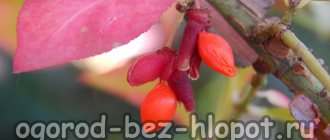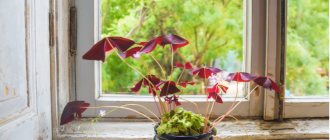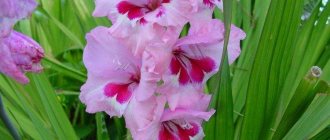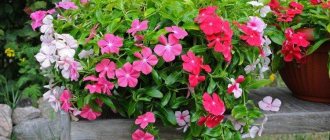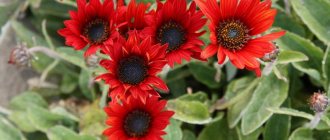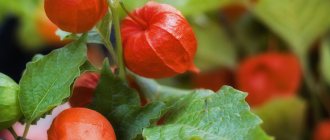Botanical description
Washingtonia (lat. Washingtonia) is a palm tree named after George Washington (the first President of the United States). There are only two species of these palms - Washingtonia filamentosa and Washingtonia stouta, and the genus itself is part of the Arekova family. The Washingtonia palm is a tree that grows up to 25 m in height and almost 1 m in diameter. But this is in its natural habitat. Fan-shaped leaves grow at the top of the trunk. Petiole up to 1.5 m long, with spines directed towards the trunk. Washingtonia rarely blooms indoors. In the USA and Mexico, baskets are woven from the fibers of the leaves, and flour is made from the fruits. In Europe, this palm is cultivated on the southern coast of the Mediterranean. At home, Washingtonia needs space and coolness. When the plant reaches a significant size, it is better to take it outside, if, of course, weather conditions allow this.
Peculiarities
Washingtonia belongs to the arecaceae or palm family .
Naturally distributed in Mexico and the southern United States. In addition to its decorative value, the palm tree is famous for its resistance to cold. Therefore, they like to place it in cool foyers and halls, in winter gardens. In winter, Washingtonia can be kept in rooms with an air temperature of 5-10℃, since at this time it begins a dormant period.
Only young palm trees are kept indoors . She grows very quickly. After it reaches a large size, it is recommended to move it outside. This can be done in regions with mild climates. Washingtonia can withstand short-term frosts down to -5℃.
Under natural conditions, a palm tree can grow up to 30 meters, and the trunk diameter reaches 1 meter. The leaves of the plant are large, fan-like.
Briefly about cultivation
- Flowering: The palm tree is grown as an ornamental foliage plant.
- Lighting: bright diffused light for 16 hours a day. In winter, additional artificial lighting is required.
- Temperature: in spring and summer – 20-24 ºC, no more, in winter – about 10 ºC.
- Watering: in spring and summer - after the top layer of the substrate has dried, in winter watering is symbolic.
- Humidity: high. During the growing season, it is recommended to spray the leaves twice a day and wash them with a damp sponge weekly. It is advisable to place containers of water around the plant. In winter, Washingtonia is not sprayed.
- Feeding: from spring to autumn 2 times a month with fertilizers with an emphasis on iron. At other times, fertilizing is not necessary.
- Dormant period: from late autumn to early spring.
- Replanting: in the spring and only if necessary: up to 7 years - once every 2 years, up to 15 years - once every three years, and after - every 4-5 years.
- Substrate: four parts turf soil, two leaves, two parts humus or peat and one part sand.
- Reproduction: seed.
- Pests: scale insects, whiteflies, spider mites and mealybugs.
- Diseases: the roots can rot from improper watering or lack of drainage in the pot, and the tips of the leaves can dry out from low air humidity.
Read more about growing Washingtonia below.
Plant characteristics
- Type: palm.
- Flower/fruit color: white.
- Leaf color: gray-green, deep green.
- Sun requirement: bright, diffused light.
- Size: up to 20-30 meters in nature.
- Flowering: Almost no blooms at home.
- Aroma: no.
If you are confident that you can provide Washingtonia with the necessary conditions for its maintenance, then by all means grow this exotic tree. Maintain the temperature, moderate watering, sufficient lighting, check for pests, then the palm tree will delight you with its extraordinary beauty for a long time.
Caring for Washingtonia at home
Lighting
The main misconception is that the Washingtonia palm tree loves the sun. When growing Washingtonia, it does not need direct rays of the sun; it needs bright but diffused light for at least 16 hours a day. It is advisable to grow Washingtonia on western or eastern windowsills. In winter or simply when daylight hours are short, additional lighting (fluorescent) is needed for normal growth. In summer, it is advisable to take Washingtonia outside to a bright but shaded place and cover it from precipitation. The room needs to be ventilated, but do not place the tree in a draft. Washingtonias need a lot of light throughout the year.
Temperature
In summer and spring, temperatures should fluctuate around 20-24 °C. If the temperature tends to 30 °C, then the plant needs to be moved to a cooler room, allowed to cool, then watered and sprinkled. In winter, the temperature should be around 10 °C. Do not be afraid, in its homeland the Washingtonia palm tree tolerates frosts down to -7 °C.
Watering Washingtonia
The Washingtonia plant at home is afraid of both waterlogging and lack of moisture, so this palm tree needs to be watered immediately after the top layer of soil has dried out - this is in spring and summer. Since the temperature drops in autumn, the frequency and abundance of watering is reduced. In winter, the main task is to prevent the earthen coma from drying out completely, i.e. water two to three days after the substrate has dried from above. Before watering, the water is allowed to settle (for a day), and watered only with warm water.
- Dracaena or Cordyline?
Spraying
For the full development of Washingtonia, high air humidity is necessary, so in addition to daily spraying (preferably twice a day), it makes sense to place a container of water next to the pot. It is a good idea to occasionally wipe the leaves with a damp cloth.
Top dressing
Washingtonias at home need fertilizer for good growth. Best of all - with an emphasis on hardware. Feed in spring and autumn 2 times a month at equal intervals. The rest of the time, as well as immediately after transplantation or during illness, Washingtonia is not fertilized.
Trimming
It is advisable to trim Washingtonia leaves before they completely dry out - this slightly slows down the natural drying of the next leaves. If the leaves are not cut off when they are dry, then the dry leaves don’t need to be cut off anymore - they will hang beautifully around the trunk.
Washingtonia transplant
Washingtonia is transplanted only if it is really necessary, since after transplantation the palm tree needs time to “come to its senses” and growth slows down a little. Up to 7 years old, Washingtonia is replanted once every 2 years, from 8 to 15 years old - once every three years, and from 15 years old - every four years (possibly after 5 years). Transshipment or transplantation should be carried out before summer, preferably in early spring. Since the palm tree is not a small tree, they are grown in wooden tubs. The substrate is made up of either turf, leaf, humus soil and sand (4: 2: 2: 1), or in the same proportions, but instead of humus, add peat. It is advisable to feed adult specimens with organic fertilizers during transplantation - about 5 kg. As the roots become exposed on the surface, you need to add fresh substrate.
Growing from seeds
The Washingtonia palm tree reproduces by seeds in the spring – March-April. Anyone who wants to achieve success with the highest probability will use only fresh seeds. The older the seeds, the lower the chance of germination and the longer the time. Before planting, the seeds need to be filed (lightly) and soaked in water for 24 hours. The seeds are deepened 1 cm into a substrate made of equal parts of moss, sand and sawdust, with the addition of crushed charcoal. The sawdust must be steamed before preparing the substrate. After planting, water the soil, cover the container with glass and place it in a warm place, maintaining the temperature at 28-30 °C. If the seeds are fresh and the care is correct, the seedlings will appear within two to three weeks. When the first leaf appears on the sprout, count the week and plant the seedling in a container with a mixture of 2 parts turf soil and one part each of leaf soil and sand. Do not worry that the leaves are not cut - the cuts will appear on the 8-9th leaf. After a year of your efforts, the Washingtonia indoor plant will already have four to five leaves. You need to pick the plant very carefully! This is how Washingtonia is grown from seeds.
Access[edit]
Joshua Tree National Park in the Mojave Desert preserves and protects examples of healthy riparian palm habitat in the Little San Bernardino Mountains and to the west where water rises through the San Andreas Fault on the east side of the valley. In the central Coachella Valley, Indio Hills Palms State Forest and the nearby Coachella Valley Preserve, other major oases are protected and accessible. Santa Rosa and San Jacinto Mountains National Monument, and Anza-Borrego Desert State Park both have large and diverse W. filifera
canyon oasis habitat.
Diseases and pests
The roots of Washingtonia are rotting. This problem occurs due to too frequent watering - the soil does not have time to dry out. The pot may have poor drainage and excess water is not draining out of the pot.
- How to plant freesia in open ground correctly
Washingtoni leaves are falling. Washingtonia requires high air humidity, and if the air is too dry, Washingtonia begins to shed its leaves.
The tips of Washingtonia leaves turn brown. This is the second problem caused by too low air humidity - spray Washingtonia more often and place a container of water next to it.
Washingtonia pests. Most often, Washingtonia is affected by scale insects, whiteflies, spider mites and mealybugs.
How to replant a flower
Like any other flower, Washingtonia is difficult to transplant. After this procedure, she needs time to adapt to new conditions and come to her senses. Therefore, it is not worth replanting the flower unless there is an urgent need. The older the palm tree becomes, the less often it is replanted.
This large flower is grown in tubs, so you need to purchase a wooden container for the palm tree in advance. The substrate consists of sand, humus, leaves and turf. During watering, the ground may sink, causing the roots to gradually protrude out. In this case, simply sprinkle soil on top so that the root system is closed.
Kinds
Washingtonia filamentous (filamentous) / Washingtonia filifera
Lives in the southern part of the USA. Under natural conditions it grows up to 20 m in height. The trunk is smooth and straight. At the top there are fan-shaped leaves that are green with a slight shade of gray. Leaves up to 2 m in length, dissected into thirds, form up to 80 lobes. There are long white threads on the edges of the leaves. Rarely blooms indoors. The flowers are white.
Washingtonia robusta (robusta) / (Washingtonia robusta)
Also known as Washingtonia sonorae . This species is a tree-like perennial that grows in nature up to 30 m in height. The leaves are fan-shaped and light green in color. In this species, the leaves are cut deeper - 2/3 of the leaf length. The petiole has a reddish tint. Blooms with white flowers.
Uses [edit]
The sweet pulp of the fan palm fruit is edible. [24] The fruit was eaten raw, cooked, or ground into flour for pies by Native Americans. [25] The Cahuilla and related tribes used the leaves to make sandals, thatched roofs, and baskets. The stems were used to make kitchen utensils. The Moapa Paiute Band and other Southern Paiutes wrote memoirs about using the seeds, fruits, or leaves of this palm for various purposes, including famine food. [26] [27] The bud (known as the heart of the palm) was also eaten. [28]
Links[edit]
- Johnson (1998). "Washingtonia filifera". IUCN Red List of Threatened Species
.
1998
. Retrieved May 11, 2006. CS1 maint: ref=harv (link) URL of old form - » Washingtonia filifera (Linden ex André) H. Wendl. Ex de Bary". Tropicos.org
. Missouri Botanical Garden. Retrieved June 20, 2014. - » Washingtonia filifera (Linden ex André) H.Wendl. Ex de Bary". PlantList. 2013. Retrieved June 20, 2014.
- Cornett, J. W. (1986). "Common name Washingtonia filifera". Principles
.
30
(4): 153–155. - Griffin, Bruce (2000). Natural History of the Sonoran Desert
. University of California Press. Page 165. ISBN 9780520219809. - Kearney, Thomas and Robert Hibbs Peebles (1960). Arizona Flora
. University of California Press. Page 164. ISBN 9780520006379. - Flora Association of North America. Flora of North America: northern Mexico.
Volume 22: Magnoliophyta: Alismatidae, Arecidae, Commelinidae (partially) and Zingiberidae . Pages 105-106. ISBN 9780195137293. - Jump up
↑ Hogan, C. Michael (January 5, 2009). "California fan palm (Washingtonia filifera)". iGoTerra. Retrieved June 20, 2014. - Clover, E.C. (April 1937). "Vegetative Survey of the Lower Rio Grand Valley, Texas." Madroño
.
4
(2): 41–66. JSTOR 41422215. - Flora Association of North America. Flora of North America: northern Mexico.
Volume 22: Magnoliophyta: Alismatidae, Arecidae, Commelinidae (partially) and Zingiberidae . Pages 116-117. ISBN 0195137299. - Cornett, James W. (1997). The Sonoran Desert: A Brief Natural History
. Palm Springs, CA: Palm Springs Desert Museum. ISBN 0-937794-27-9. - Cornett, James W. (1987). Naturalized populations of the desert fan palm, Washingtonia filifera, at Death Valley National Monument in Eastern California Plant Biology
. Los Angeles, CA: White Mountain Research Station, University of California, Los Angeles. pp. 167–174. - Mark Nothaft (March 22, 2016). “Are palm trees native to Arizona?” . Retrieved March 26, 2016. Mark Fleming, curator of botany at the Arizona-Sonora Desert Museum in Tucson, says that Washingtonia filifera
, or California fan palm, is the state's only native variety, and that they occur in pockets around southern California, northern Mexico and one or two pockets in Arizona . - "Plant profile for Washingtonia filifera (California fan palm)". Natural Resources Conservation Service
. US Department of Agriculture. Retrieved June 20, 2014. - Govaerts, R. “Washingtonia filifera (Rafarin) H. Wendl ex - de Bari, Bot Zeitung (Berlin) 37:. LXI (1879)". World Checklist of Selected Plant Families
. Retrieved June 21, 2014. - Cornett, J. W. 1986. Arthropod visitors in Washingtonia filifera (Wendl) Flowers. Pan-Pacific Entomologist 62(3):224-225.
- "Desert Fan Palms - Evidence Suggests 'Heirloom Genus'." www.xeri.com
. Retrieved December 10, 2016. - Vogl, Richard; McHarg, Lawrence (1966). "Vegetation of California fan palm oases on the San Andreas Fault". Ecological Society of America
.
47
(4):532–540. DOI: 10.2307/1933929. JSTOR 1933929. CS1 maint: multiple names: list of authors (link) - Nisson, N.; Hodel, D.; Hoddle, M. "Red Palm Weevil". Invasive Species Research Center
. University of California, Riverside. Retrieved June 20, 2014. - Dembilio, O.; Jacas, J. A.; Llaser, E. (August 2009). "Are Washingtonia filifera
and
Chamaerops humilis
suitable hosts for the red palm weevil
Rhynchophorus ferrugineus
(Col. Curculionidae)?"
Journal of Applied Entomology
.
133
(7):565–567. DOI: 10.1111/j.1439-0418.2009.01385.x. S2CID 85677945. - Monroy, F.; Curir, P.; Clematis, F.; Cangelosi, B. (June 2016). "Susceptibility and possible mechanisms of resistance in palm species Phoenix dactylifera, Chamaerops humilis and Washingtonia filifera against Rhynchophorus ferrugineus (Olivier, 1790) (Coleoptera: Curculionidae)". Bulletin of Entomological Research
.
106
(3):341–346. DOI: 10.1017/S000748531500108X. ISSN 0007-4853. PMID 26976073. S2CID 206225113. - Cornett, James W. (2010). Desert Palm Oasis
(Second ed.). Palm Springs, CA: Nature Trails Press. ISBN 978-0-937794-42-5. - "Global Warming and W. filifera Palms - A Rebuttal". www.xeri.com
. Retrieved December 10, 2016. - Little, Elbert L. (1994) [1980]. Audubon Society Field Guide to the Trees of North America: Western Region
(Chanticleer Press). Knopf. item 325. ISBN 0394507614. - Cornett, James W. (2011). Indian Uses of Desert Plants
(Third ed.). Palm Springs, CA: Nature Trails Press. ISBN 978-0-937794-45-6. - Spencer, W. (1995). "Washingtonia filifera: Nevada's rejected ancient palm". xeri.com. Retrieved June 21, 2014.
- Spencer, W. (1995). "Report on: Palm - Washingtonia filifera - in Moapa, Nevada". xeri.com. Retrieved June 21, 2014.
- Peattie, Donald Culross (1953). Natural History of Western Trees
. New York: Bonanza Books. paragraph 299. - "Washingtonia filifera: Washington palm". RHS Horticulture
. Royal Horticultural Society. Retrieved June 21, 2014. - "California Fan Palm, Washingtonia filifera". realpalmtrees.com
.
External links [edit]
| Wikimedia Commons has media related to Washingtonia filifera . |
- USDA Plant Profile: Washingtonia filifera (California fan palm)
- UC Jepson Manual Treatment - Washingtonia filifera
- Calflora Database: Washingtonia filifera (California Fan Palm)
- Washingtonia filifera in the flora of North America
- Washingtonia filifera (California Fan Palm) - UC CalPhotos Gallery
| Taxon identifiers | |
| Washingtonia filifera |
|
| Pritchardia filifera |
|
Reproduction of Washingtonia
Palm plants are not suitable for leaf propagation. Washingtonia is propagated from seeds. To do this, prepare the soil; turf or compost soil is suitable. Before planting Washingtonia seeds, the soil should be steamed.
The seeds do not need to be planted deeply; for seedlings, take small pots and plant the seeds in depressions about 0.5-1 centimeters deep, but Washingtonia grows long roots, so the pots should not be “squat”, as for orchids or violets, do not forget that We are dealing, albeit with a small one, but a palm tree!
Young boring plants will feel good at a temperature slightly above room temperature, approximately 25°C. The plant will feel best on the window, above the radiator, since bottom heating is important for the plant, but avoid drafts.
Where to put
— Lighting . Try to find a sunny place indoors, preferably a place where the palm receives direct sunlight.
- Temperature . In general, it is resistant to changes and temperature fluctuations; it is advisable to choose a place where there will be a constant temperature, the main thing is that it does not fall below 0.
- Humidity . We regularly spray the plant or wipe the leaves with a damp cloth.

